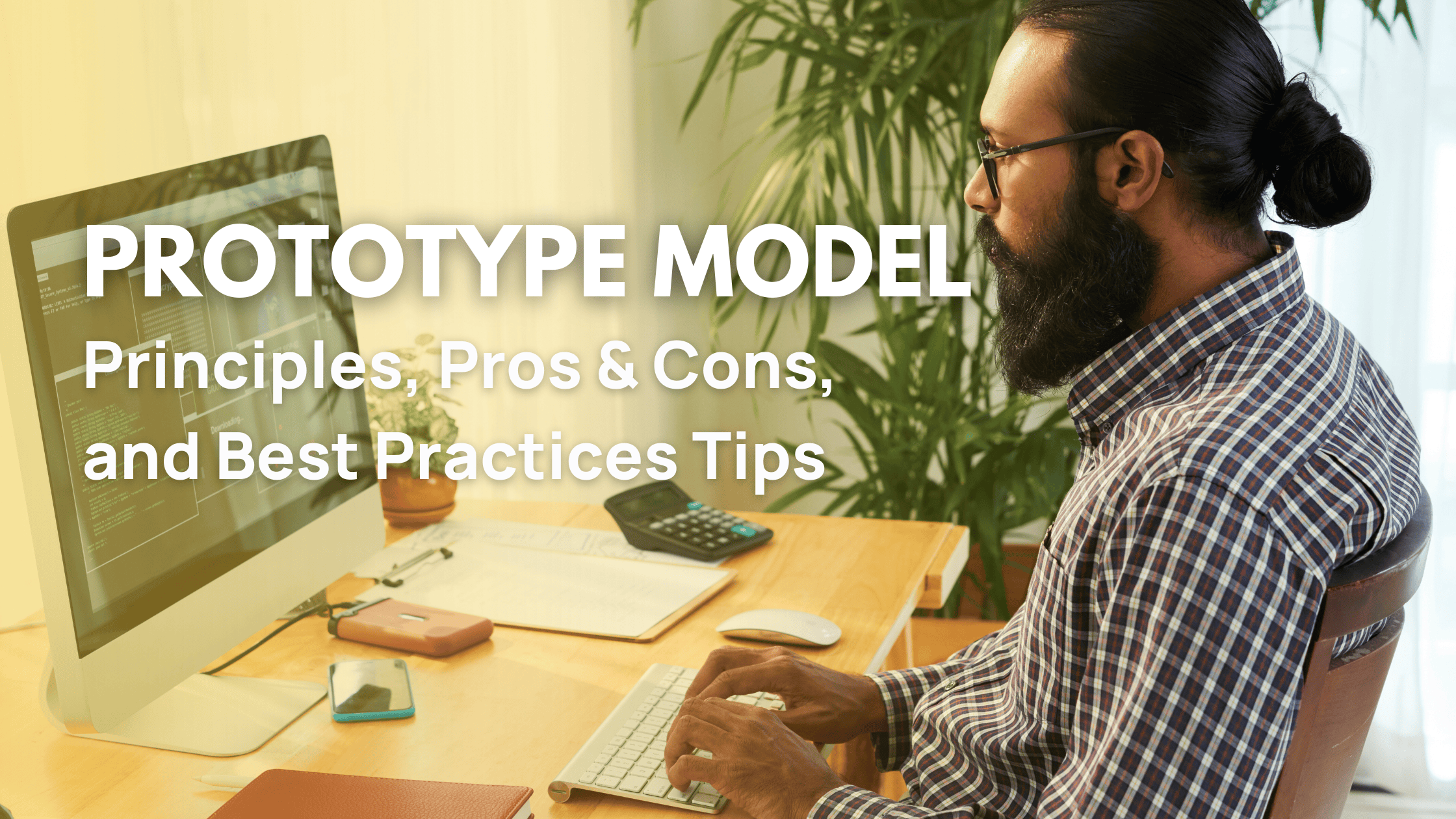Development teams strive to build software that perfectly aligns with customer needs, yet, they often face a significant challenge in the initial stages of project development: clients frequently struggle to articulate their exact requirements and desired features.
Most customers approach software development with a general concept rather than a detailed specification. Still, translating customers' vision into technical requirements and functional specifications is not an easy task. Also, a gap between concept and implementation can happen if two parties are lack of effective communication.
The solution to bridge the gap is Prototype Model. By creating working models early in the development process, teams can transform ideas into tangible solutions that customers can experience.
To further understand how Prototype Model can bridge the gap between concept and implementation, let's begin with the core concepts of the Prototype Model.
What is Prototype Model in Software Engineering?
At its core, prototyping model approach involves building functional, scaled-down versions of the intended software system that stakeholders can interact with and evaluate. The prototype is continuously refined and updated in response to customer feedback.
This process will carry on until the prototype meet the project’s requirement.
Understanding Software Prototypes
A software prototype serves as a preliminary model of the final product.
It implements select features and functionalities that demonstrate the system's core capabilities, allowing stakeholders to:
Visualize the end product early in development.
Experience hands-on interaction with key features.
Identify potential issues before full-scale development.
Purpose and Objectives
The primary goals of the Prototype Model include:
Requirements Clarification: Converting abstract ideas into tangible software demonstrations.
User Experience Validation: Enabling stakeholders to interact with the system and provide feedback.
Risk Mitigation: Identifying potential issues and challenges early in the development cycle.
Communication Enhancement: Bridging the communication gap between technical teams and business stakeholders.
Cost Efficiency: Reducing costly changes during later development stages.
Learning from Prototypes
It's important to understand that early prototypes are intentionally imperfect:
They may have limited functionality.
Performance might not be optimized.
Some features may be simulated.
However, these limitations serve a valuable purpose as they:
Encourage stakeholder feedback at a stage where changes are less costly.
Allow rapid iterations based on user input.
Help validate the technical feasibility of proposed solutions.
6 Phases in Prototyping Model
The Prototype Model follows a structured Software Development Life Cycle (SDLC) approach, consisting of six distinct phases. Each phase builds upon the previous one, creating a systematic process for developing software.
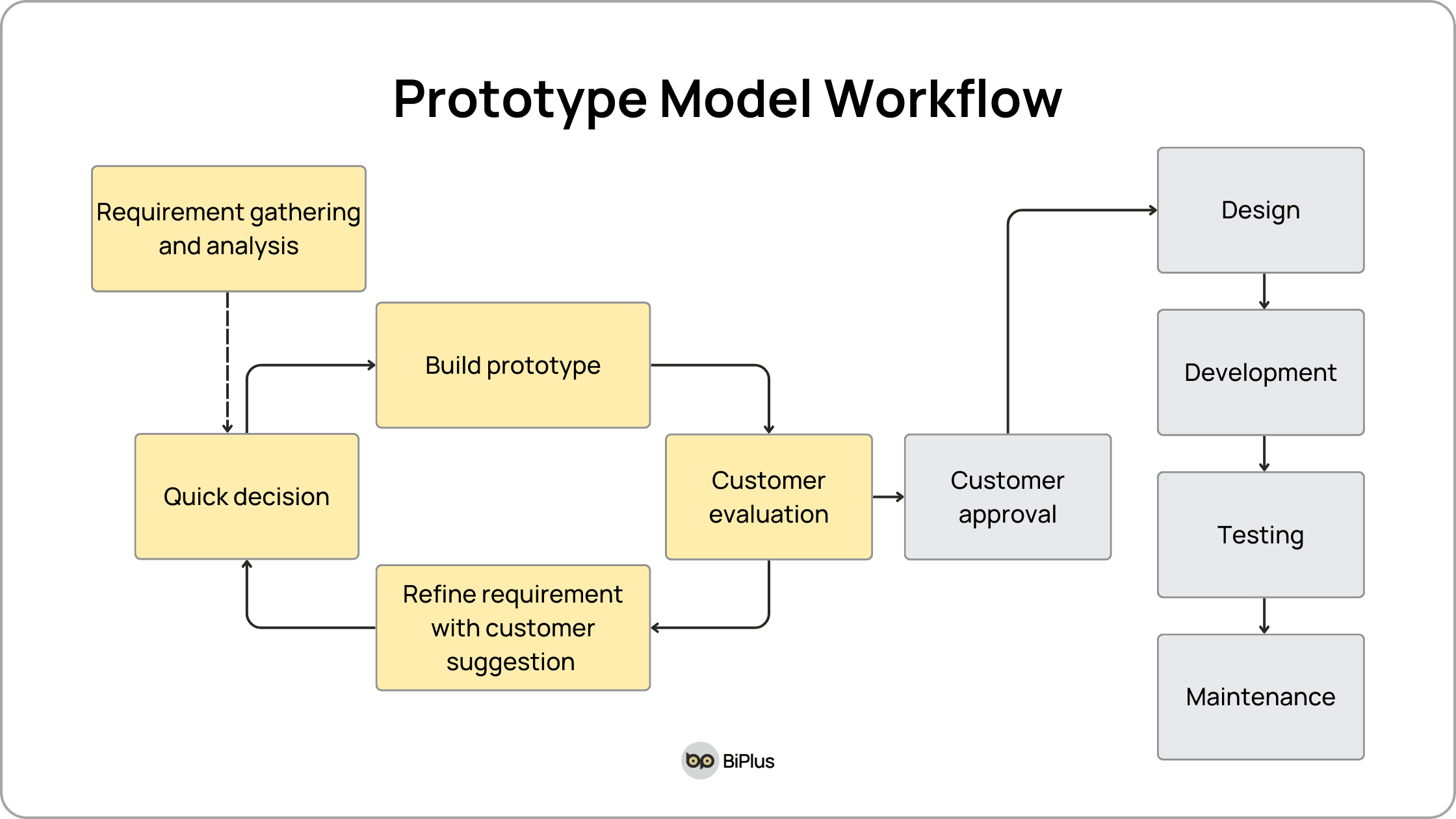
1. Requirements Gathering and Analysis
In this initial phase, development teams focus on:
Conducting in-depth stakeholder interviews.
Clarifying functional and non-functional requirements.
Creating detailed requirement specifications.
Establishing evaluation benchmarks.
This phase transforms vague concepts from customers into actionable requirements that guide the development process.
2. Quick Design
The second phase involves creating a basic design framework that:
Outlines the software's fundamental architecture.
Defines core system components and their relationships.
Establishes basic user interface layouts.
Identifies key technical requirements.
Sets the foundation for prototype development.
This preliminary design serves as a blueprint for the initial prototype.
3. Prototype Construction
During this phase, developers create a working model based on the quick design with core functionalities and system operations, basic user interfaces, and database structures.
The resulting prototype is a scaled-down, but functional version of the intended system.
4. Stakeholder Evaluation
In this phase, customers can experience the working prototype and provide their feedback on the functionality. Meanwhile, the mission for the team includes:
Gathering detailed feedback on functionality from customers.
Documenting suggested improvements.
Identifying missing features or requirements.
5. Refinement
Based on stakeholder feedback, the team:
Modifies the prototype design and implements requested changes.
Adds new functionality.
Improves user interface elements.
This iterative phase may repeat multiple times until stakeholders are satisfied with the prototype.
6. Product Engineering
The final phase transforms the approved prototype into a production-ready system as the team:
Implement full functionality.
Conduct thorough testing.
Prepar documentation.
Deploy the final product.
This phase ensures the final product meets all requirements while maintaining high quality standards.
4 types of Prototyping Model
Prototyping isn't a one-size-fits-all approach. There are different prototyping strategies for different project requirements, timelines, and objectives.
Here are 4 types of prototyping model:
Rapid Throwaway Prototyping
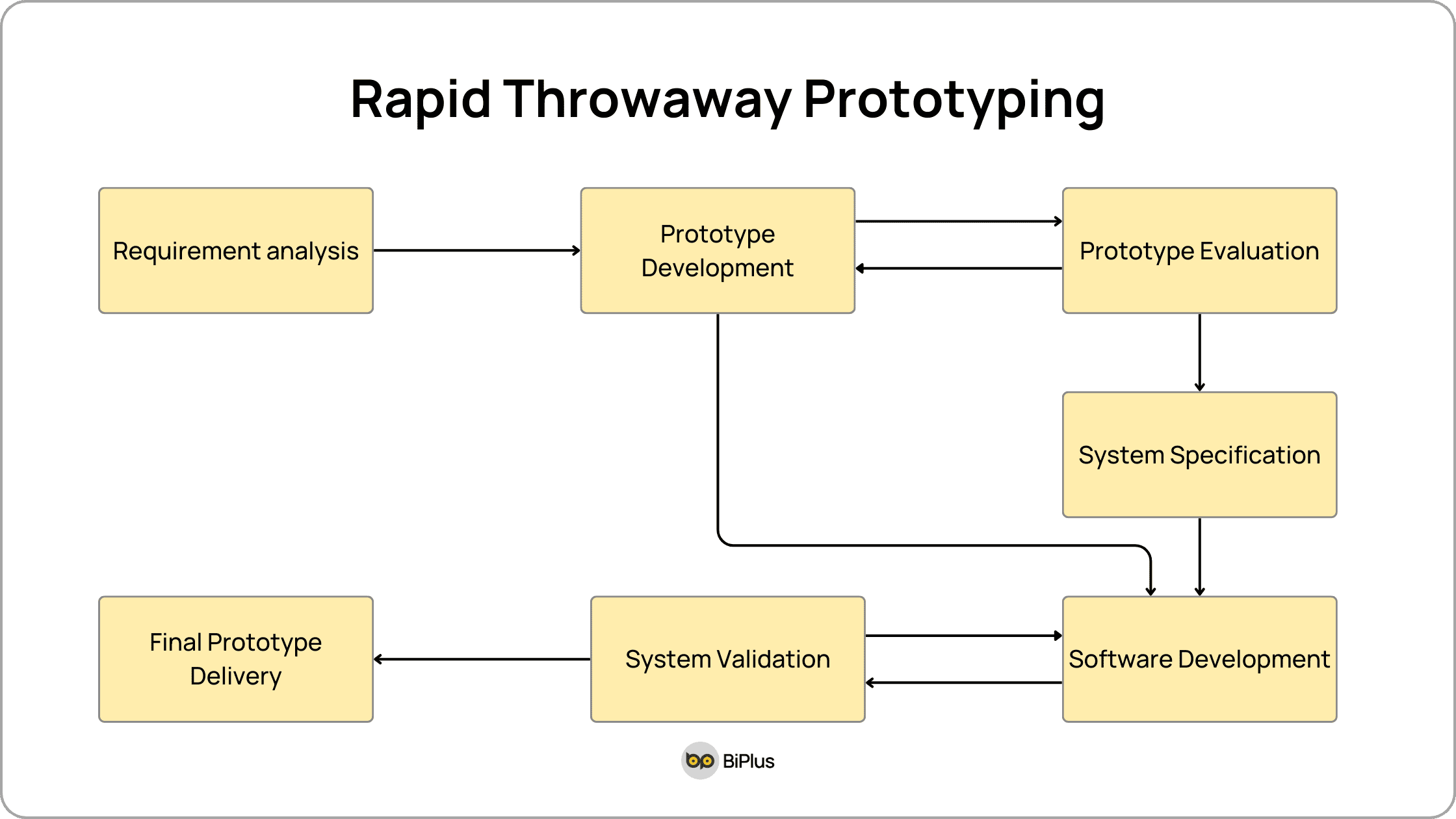
In this approach, development teams quickly create a prototype based on preliminary requirements from stakeholders. The prototype undergoes continuous updates based on customer feedback until it meets their expectations. The insights and requirements are carefully documented for future reference.
However, once the prototype has served its purpose in clarifying requirements and validating concepts, it is "thrown away," and the actual development begins from scratch.
Key Characteristics:
Quick development cycle.
Minimal investment in prototype code.
Focus on customer feedback.
This approach is particularly effective for:
Testing new product concepts.
Experimenting with innovative features.
Clarifying vague requirements early in the project.
Evolutionary Prototyping
Evolutionary Prototyping stands apart from conventional prototyping approaches through several distinctive characteristics:
The prototype serves as a working foundation of the final system, containing actual functional components rather than just simulations.
It incorporates system requirements identified by the development team, though it may not initially address all customer-specific requirements.
Each new iteration builds upon the previous version, progressively adding enhanced features and functionality.
Unlike Rapid Throwaway Prototyping, which discards each prototype version, this approach continuously evolves the initial prototype. This progressive development strategy significantly reduces development time and resource consumption.
This approach proves effective in scenarios such as:
Projects implementing novel technologies or new technical stacks where team experience and documentation are limited.
Complex systems requiring extensive functionality and feature validation.
Long-term projects where maintaining development continuity is important.
Incremental Prototyping
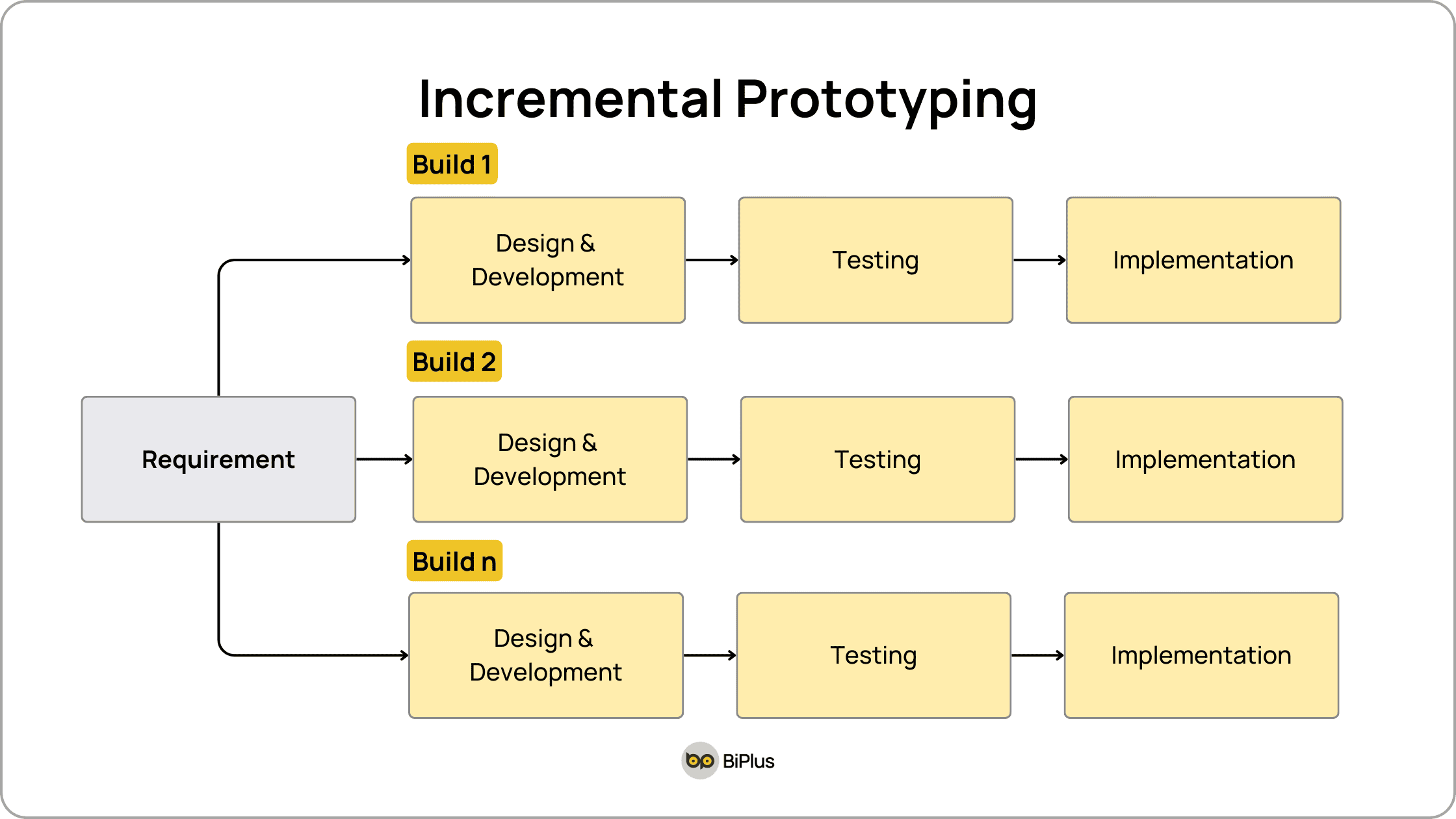
In Incremental Prototyping, development teams break down the final product into separate, manageable components that are developed independently before being integrated into the complete system.
This modular approach offers several advantages:
Each component is designed and developed separately, allowing for focused development and testing.
Teams can prioritize critical components while developing less essential features in parallel.
Risk management becomes more manageable as issues can be identified and resolved at the component level.
This approach significantly streamlines the development process as the complex systems are broken down into smaller, more manageable pieces. This facilitates easier testing and debugging and allows faster delivery of core functionality.
However, successful implementation requires:
Thorough system architecture planning before prototyping begins.
Clear understanding of component dependencies and interfaces.
Strong integration strategy to ensure components work together seamlessly.
Extreme Prototyping
Extreme Prototyping is the preferred methodology for web application development, offering a structured, three-phase approach to building modern web solutions. The process conducts in three distinct phases:
Phase 1: Static Layout Development
Creation of HTML wireframes to visualize page layouts.
Mapping of user journeys and navigation flows.
Establishment of visual hierarchy and content structure.
Phase 2: Interactive Prototype Development
Transformation of static wireframes into interactive HTML pages.
Implementation of user interface behaviors and animations.
Integration of mock data and service layers.
Creation of responsive design elements.
Phase 3: Services Implementation
Development of actual backend services.
Integration of real data processing.
Finalization of system functionality.
This approach delivers several key advantages:
Accelerated development cycles.
Early visualization of user experience.
Reduced risk of design-development misalignment.
Advantages and Disadvantages of Prototype Model
Advantages and Disadvantages of Prototype Model
| Advantages | Disadvantages |
|---|---|
Active involvement | Time-consuming |
Easy detection of missing functionality | Misconception regarding the arrival of the final product |
Quick feedback | Poor decision-making |
Higher client satisfaction | Misunderstanding regarding the final version |
Flexibility | High upfront cost |
Money Saving | Insufficient analysis |
Every software development methodology comes with its own set of advantages and disadvantages. Understanding these trade-offs is crucial for making an informed decision about whether the Prototype Model is the right choice for your project.
For a comprehensive analysis of the Prototype Model's advantages and disadvantages, explore our detailed guide: Prototype Model: All Advantages and Disadvantages 👈
When to use Prototype Model in Software Engineering?
To maximize project success and resource efficiency, development teams should consider implementing the Prototype Model in specific scenarios where its benefits can be fully realized.
Here are the key situations where this approach proves most valuable:
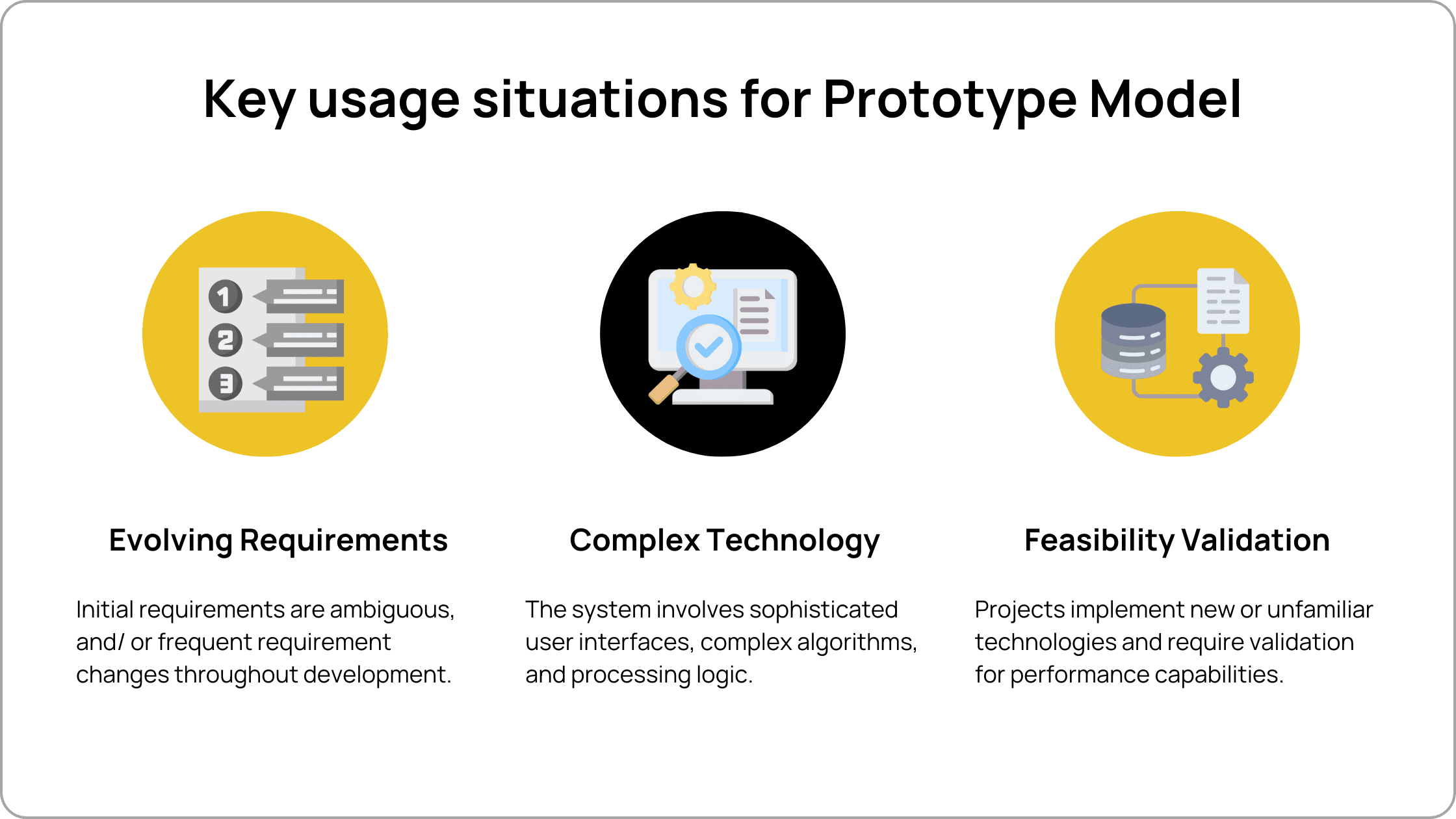
Unclear or Evolving Requirements
Initial requirements are ambiguous or poorly defined.
Stakeholders expect frequent requirement changes throughout development.
Business needs are likely to evolve during development.
Complex Technical Requirements
The system involves sophisticated user interfaces requiring user validation.
Project includes complex algorithms or processing logic.
Technical Feasibility Validation
New or unfamiliar technologies are being implemented.
Performance capabilities must be demonstrated early.
Key Takeaways for Optimizing Prototyping Model Practices
While the Prototype Model provides a solid framework for software development, success ultimately depends on how effectively teams implement and utilize the approach.
For Development Teams
Each Prototype Iteration should be carefully planned, along with proper documentation of changes.
A feature prioritization framework can help team focus on implementing critical functionalities first, and track development progress systematically.
Based on team capacity, development team can proactively adjust iteration scope and balance development speed with software quality.
For communicating with stakeholders
It’s essential to keep stakeholders informed about potential technical constraints. This will set realistic expectations about prototype capabilities and gain shared agreement on risk mitigation strategies.
To maintain transparent communication about progress, clear feedback channels and regular stakeholder review meetings are required.



